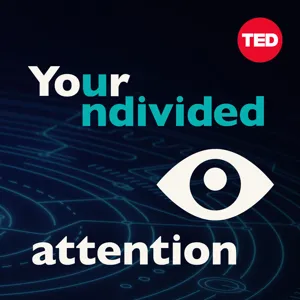Podcast Summary
Rewilding the Arctic with Woolly Mammoths: Scientists aim to restore Arctic grasslands with lab-grown mammoths to preserve permafrost and reduce carbon emissions
A small group of Russian scientists is attempting to rewild a large area of Northern Siberia, Alaska, and the Canadian Yukon with an ice age grassland biome, including lab-grown woolly mammoths, as a climate change mitigation strategy. The permafrost, which is rich in organic matter and carbon, is melting rapidly due to the Arctic's warming temperatures. This release of carbon could accelerate climate change. The scientists' plan is to restore the Arctic's grassland ecosystem to help preserve the permafrost and prevent the release of this carbon. This project highlights the power of narrative and marketing in bringing seemingly crazy ideas from the lab to reality. It also showcases the importance of considering the sociocultural and economic aspects of radical geoengineering projects. While the idea of bringing back woolly mammoths may seem far-fetched, the scientists' primary motivation is to mitigate climate change and preserve the Earth's carbon stores.
Large herbivores like woolly mammoths keep Arctic grasslands intact: Woolly mammoths and other large herbivores prevent tree growth, maintaining Arctic grasslands which reflect sunlight and keep earth cool, acting as a natural buffer against climate change. Without them, grasslands become carbon intensive and contribute to climate change.
The presence of animals, particularly large herbivores like woolly mammoths, plays a crucial role in maintaining the grasslands in the Arctic region. These grasslands help reflect sunlight and keep the earth beneath them colder, acting as a natural buffer against climate change. The decomposition of organic matter released when these grasslands melt and trees grow in their place can contribute to carbon emissions. Woolly mammoths, and other large herbivores, help prevent tree growth by knocking down trees, maintaining the grassland ecosystem. Without these animals, the process of creating and maintaining grasslands becomes carbon intensive and problematic. The extinction of woolly mammoths and other large herbivores may have paved the way for the growth of forests in the Arctic, contributing to climate change.
The Impact of Humans on Extinct Large Mammals: Humans led to the decline of large mammals during the ice age due to their adaptation to hunting in grasslands. The woolly mammoth's extinction and efforts to reintroduce it highlight our fascination and connection with these animals.
Humans, as described by Yuval Harari in Sapiens, have had a profound impact on Earth's ecosystems, leading to the decline of large mammals, particularly during the ice age. This was due to humans' ability to adapt to hunting in grasslands, where large animals no longer had the advantage of hiding behind trees or rocks. The woolly mammoth is a particularly romanticized extinct animal, and the story of two men, Sergei and Nikita, in the Siberian Arctic trying to rewild the area with extinct woolly mammoths highlights the fascination and connection people have with these animals. The hypothesis is that African megafauna survived because they had evolved with humans, recognizing them as dangerous predators. This narrative journalism piece in The Atlantic also showcases the scientific characters and their roles, such as the mammoths and elephants, which are essential parts of understanding the story of human history and the impact on Earth's ecosystems.
Creating Asian Elephants with Woolly Mammoth-like Characteristics using CRISPR: Scientists are using CRISPR technology to modify Asian elephant genomes to create creatures with woolly mammoth-like characteristics, such as cold-resistant adaptations, by making minimal tweaks and letting nature refine the modifications through subsequent generations.
Scientists are using CRISPR technology to modify Asian elephant genomes to create creatures with characteristics similar to those of woolly mammoths, inspired by their historical significance and resonance with human emergence. This process involves adding cold-resistant adaptations such as cold-resistant hemoglobin, a full body layer of insulating fat, and shrinking ears, mimicking the natural modifications that occurred when elephants migrated to colder climates. The goal is to make as few tweaks as possible and let nature refine the modifications through subsequent generations. However, it's important to note that the aim is not to recreate the exact woolly mammoth genome but rather to create an Asian elephant with woolly mammoth-like characteristics. Despite advancements in DNA sequencing, there is still uncertainty about the exact woolly mammoth genome, making the project more of an approximation rather than a replication.
Manipulating ancient DNA for extinct animals comes with challenges: While the concept of reviving extinct animals through DNA manipulation is intriguing, the reality involves complex challenges including DNA degradation, cultural transmission, and ethical considerations.
While the idea of manipulating ancient DNA to bring extinct animals back to life may sound intriguing, the reality is that DNA degrades over time and introducing new animals into ecosystems comes with significant challenges. The social structures and cultural transmission of knowledge that exist among social animals like elephants are complex and cannot be easily replicated. Moreover, the language and metaphors used to describe genetic engineering can obscure the reality that humans have been shaping the natural world for centuries through selective breeding and other means. The philosophical tension around playing God is not new, but it's important to remember that humans have already had a profound impact on the Earth through the removal of 95% of megafauna. In the context of gene editing, we are currently working on editing 15 of the 95 genes required, with 30 being tweaked and an estimated 50 more needed. The ethical and ecological implications of this technology are complex and require careful consideration.
Bringing extinct animals back to life: The woolly mammoth and the challenge of artificial wombs: Although gene editing technology may bring extinct animals like the woolly mammoth back, the ability to grow them in an artificial womb is still a significant technological challenge and decades away. Understanding genetic changes' impact on an animal's body is crucial before making definitive statements.
While gene editing technology holds promise in bringing extinct animals back to life, such as the woolly mammoth, the process of growing them in an artificial womb is still a significant technological challenge that is decades away. Beth Shapiro, an expert in the field, emphasizes the importance of understanding how genetic changes interact with the rest of the animal's body before making definitive statements about bringing mammoths back. Additionally, the Ice Age, formally known as the Pleistocene age, is not just a period of ice but also a crucial time in human history where we discovered fire, developed language, and advanced tool use. This period, which lasted for approximately 300,000 years, laid the foundation for human civilization as we know it.
The Importance of Grass in the Ecosystem: Grasslands are some of the most productive ecosystems due to the symbiotic relationship between grasses and grazers, resulting in nutrient-rich fertilizer and continuous growth.
Grass plays a crucial role in the ecosystem, particularly in the rise of humans. Contrary to popular belief, grass is a relatively new biome on the planet, but it grows quickly and is abundant. Grasses thrive on being eaten and partner with grazers to enhance nutrient flows in their ecosystems. When animals graze on grass, they poop out nutrient-rich fertilizer, which grasses absorb and use to grow even more. This cycle of growth and decay makes grasslands one of the most productive ecosystems on the planet. This counterintuitive idea was a revelation to the speaker, who had always romanticized forests, but was captivated by the importance of grass in the context of human history.
Exploring Our Past Through Scientific Advancements: Understanding Our Human Condition and Longing for What Once Was: Exploring the past through scientific advancements provides valuable insights into our humanity and helps us understand our longing for what once was, known as solastalgia. It's crucial to consider the long-term implications of our actions and the intersection of science and society, which can lead to unexpected encounters.
The exploration of our past through scientific advancements, such as the study of ancient grains like wheat, rice, and corn, allows us to understand our human condition and experience a sense of longing for what once was. This concept, known as solastalgia, represents an existential grief or vanished landscape. As we navigate our existence in the present and look towards the future, it's essential to consider the long-term implications of our actions, which may involve looking back at our history for over 10,000 years or even further. An interesting juxtaposition exists between the past and present, as seen in the Arctic research stations and their access to modern conveniences like Amazon Prime and Apple. Additionally, the intersection of science and society can lead to unexpected encounters with cultural realities, such as poachers and personal relationships. Overall, delving into our past through scientific discoveries offers valuable insights into our humanity and our place in the world.
Reintroducing extinct animals to the Arctic: Socio-economic challenges: Projects to reintroduce extinct animals to the Arctic, like Pleistocene Park, face complex socio-economic challenges, including interactions with local communities and potential income sources from sales of ivory or dinosaur eggs.
The expansion of projects like Pleistocene Park, which aims to reintroduce extinct animals to the Arctic, presents significant socio-economic challenges and requires making peace with the human world on a grand scale. These projects, while funded by various governments and scientific institutions, involve complex trade-offs and interactions with local communities. For instance, the potential sale of ivory or dinosaur eggs could provide much-needed income for struggling towns. Another project, the American Prairie Reserve, faces similar challenges in its efforts to rewild grasslands, albeit without the "sexy" extinct creatures or climate change mitigation strategies to attract funding. The process of gaining access to these remote regions can also be fraught with unexpected challenges, as demonstrated by the experience of filmmakers seeking to document the project.
Effectively promoting unconventional ideas: Compelling narrative, sincere belief, and urgency are key to promoting unconventional ideas. Success stories include the man with a Russian propaganda T-shirt and Elon Musk's projects.
The ability to successfully promote unconventional ideas, even those that may initially sound absurd, requires a combination of compelling narrative, sincere belief, and a sense of urgency or readiness. This was exemplified in the story of a man mistaken for a spy due to a Russian propaganda T-shirt, as well as the eventual acceptance of a controversial climate change paper. The success of figures like Elon Musk in gaining widespread support for their esoteric projects underscores the importance of these elements. However, it's important to note that the line between persuasive communication and manipulation can be blurry, and the sincerity and intentions of the person promoting the idea should be carefully considered. Ultimately, the power of an idea lies not only in its merit, but also in how effectively it is communicated and the cultural and societal context in which it is presented.





